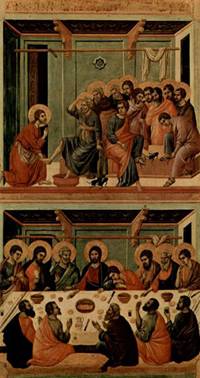
A 14th century painting of the footwashing and Passover meal by Duccio di Buoninsegna.
One of the first annual events of the Christian year, after the celebration of the resurrection on every Lord’s Day, was a commemoration of Christ’s dying and rising at Easter. Over the years, one day was split into three different rituals to remember the Last Supper and New Commandment (Maundy Thursday), the Crucifixion (Good Friday) and the struggle to make meaning of the cross in light of the whole of salvation history (the Great Vigil) — all culminating in Easter at day break.
What was originally one annual service remembering the Lord’s death and resurrection became split into separate services in order to pay closer attention to the significant details of Christ’s death and resurrection. These were considered to be part of one salvific activity of God and thus celebrated as such without a benediction until the end of the service with the Easter announcement that “Christ is risen!”
The Three Days or Triduum (Maundy Thursday at sundown through sundown of Easter) are the most solemn of the church year. The whole church’s participation is encouraged in this time of great significance for all who would be formed in the Christian faith, especially catechumens. The Great Vigil of Easter was the time set aside for the annual baptism of new Christians, coinciding with the eucharistic dawning of God’s reign in the risen Lord Jesus Christ.
A continuous dramatic story
An excerpt from the Companion to the Book of Common Worship (Geneva Press, 2003, 113)
All of Holy Week points toward the passion — the death and resurrection of Christ. The week’s final three days (from sunset Thursday to sunset on Easter) complete the commemoration of Christ’s passion. These three days are called the Triduum.
The Triduum engages us from Thursday until Sunday in a unified act. What happens on Maundy Thursday, Good Friday, and the Easter Vigil forms a continuous dramatic story. These days are to be seen together rather than separately. The services for the three final days of Holy Week connect with one another and, together, comprise the oneness of the Triduum.
Because of this interrelationship of the three days, each service of the Triduum needs the others to tell the whole story. For example, resurrection is incomprehensible without Christ’s self-giving in crucifixion and at the Lord’s Supper. Therefore, Easter needs Good Friday and Maundy Thursday to be fully understood. The way to the triumph of Easter is through the Triduum.
All of Holy Week, and particularly its three concluding days (the Triduum), provides an opportunity to undertake a pilgrimage of renewed commitment and joy; to travel Christ’s path of servanthood, through the Lord’s Supper and the suffering of the cross, as we move toward Easter. Our joy during the great festival of resurrection will be enhanced by faithful participation in worship during the preceding week, especially during the whole of the Triduum.
Resources for Triduum / Three Days
View videos of lectures by Dr. Gail Ramshaw on the Great Three Days.
Notes explaining the Triduum / Three Days
These brief bulletin inserts are provided to help convey the sense of continuity that unites the services of the Triduum or Three Days.
Ways to celebrate the Three Days
Use these ideas to observe Maundy Thursday, Good Friday, Holy Saturday, and Easter Sunday.
Daily prayer during Holy Week
These daily services for Morning, Midday and Evening Prayer are designed particularly for Holy Week but are appropriate for use throughout the Season of Lent.
Hymns for Holy Week
Explore a Daily Hymn-Prayer Guide for Holy Week, featuring the hymns of Carolyn Winfrey-Gillette.
Passion / Palm Sunday | Maundy Thursday